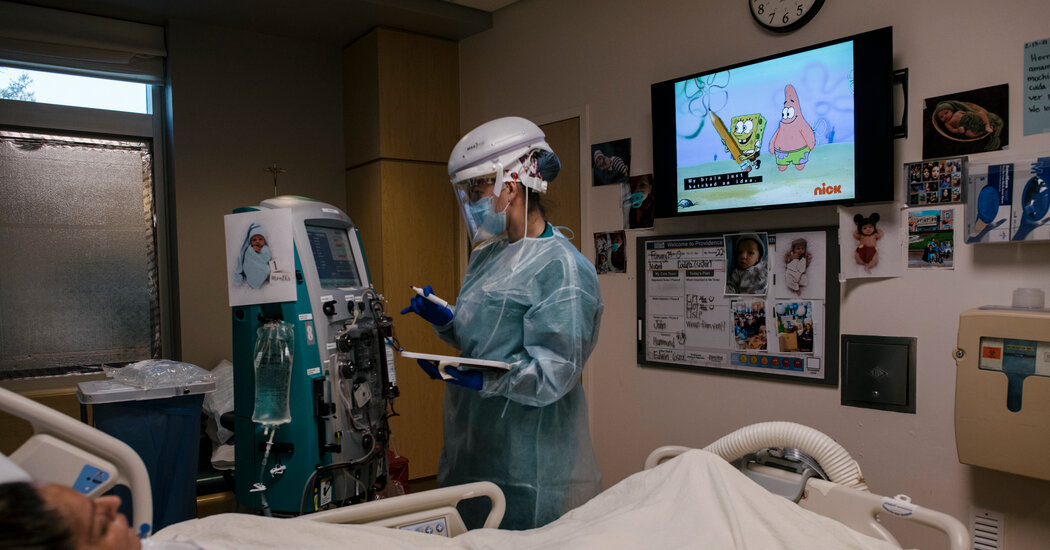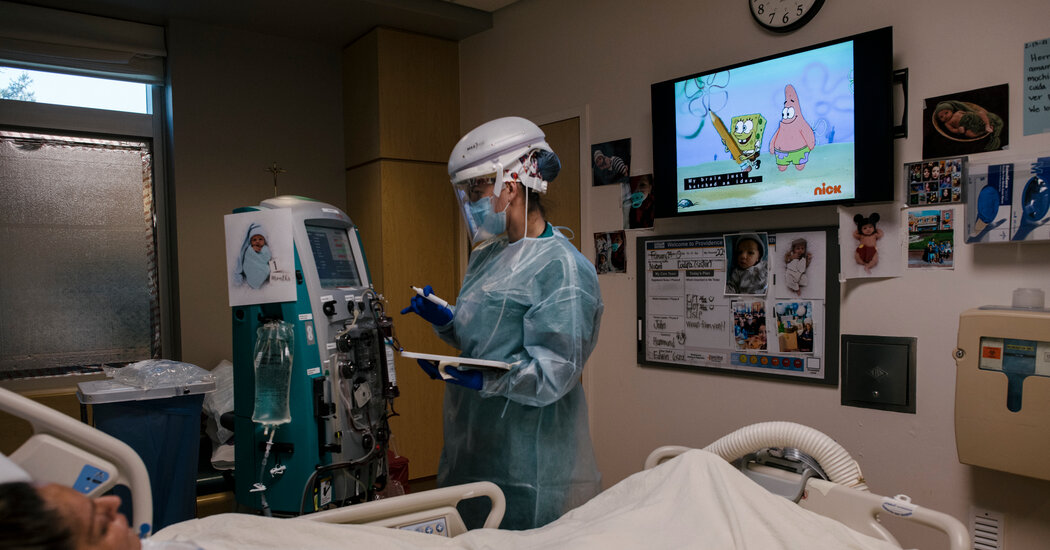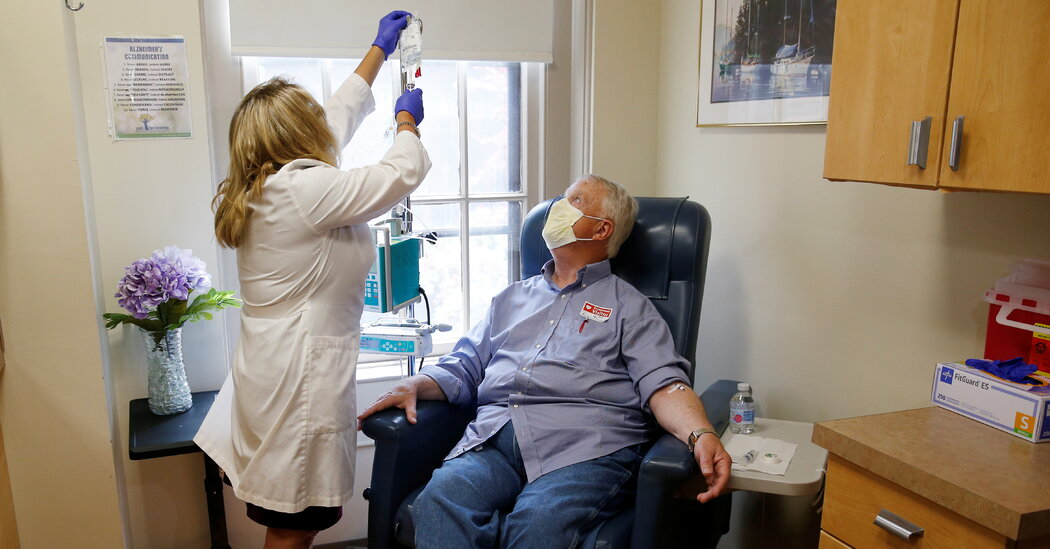Concerns Grow Over Safety of Aduhelm After Death of Patient Who Got the Drug
Newly published safety data shows that 41 percent of patients in key clinical trials of the Alzheimer’s drug experienced brain bleeding or swelling, though many cases were asymptomatic.Concerns about safety risks of the controversial new Alzheimer’s drug Aduhelm have intensified in the wake of the death of a 75-year-old woman who experienced brain swelling after receiving infusions of the drug as a participant in a clinical trial.The death of the woman, who lived in Canada, occurred in late September and was reported by a doctor to the Food and Drug Administration’s adverse event reporting system this summer. It is being investigated by both the F.D.A. and Biogen, which makes the drug, also known by its scientific name, aducanumab.In a statement Biogen said: “The cause of death is unknown at this time. We know the 75-year-old clinical trial patient was admitted to the hospital with a seizure” and diagnosed with brain swelling.“Following a prolonged hospitalization, the patient was being prepared for discharge when she deteriorated and was transferred to another facility,” the statement continued. “We have requested missing information, including brain imaging, from the critical last nine days of hospitalization.”Last week, Brian Abrahams, a biotech analyst with RBC Capital Markets who has a medical degree, wrote to clients that he had obtained the woman’s case report through a public records request and had concluded that the brain swelling probably caused the woman’s death and “that this is likely to have been caused by aducanumab.”In its statement, Biogen said that “the RBC report only provides a partial view of the case,” adding, “We take this event very seriously and continue to work with the reporting investigator.”In a note earlier this month, Dr. Abrahams, whose assessments of the case were reported previously by Endpoints News, Fierce Pharma and other publications, wrote that the report suggested that the patient “did not appear to have any other contributing conditions listed.”Brain swelling and brain bleeding are known to be possible side effects of Aduhelm, a monoclonal antibody that is administered as a monthly infusion. The F.D.A. approved the drug in June even though a council of senior F.D.A. officials, an advisory committee of outside experts, and many Alzheimer’s specialists said it was unclear whether Aduhelm could benefit patients and that the drug carried serious risks of harm.On Aduhelm’s label, the F.D.A. warns about these brain side effects, known as amyloid related imaging abnormalities (ARIA), and advises physicians to monitor patients and obtain two M.R.I. brain scans during the first year of treatment. The label does not say that people with ARIA should necessarily be taken off the drug. Many cases of ARIA are mild or asymptomatic, but some can be serious.Between July and September, three other cases of ARIA were reported to the F.D.A.’s adverse event database, all requiring hospitalization. Biogen said it was also reviewing those cases.In a recent statement, the American Academy of Neurology noted that “the F.D.A. label calls for less frequent monitoring than was performed in clinical trials” and said that “additional MRIs will often be needed in response to changes in patients’ clinical condition.”The academy said that when talking with patients and families, “neurologists must communicate information about potential adverse effects and the burdens of monitoring.”Dr. Sam Gandy, an Alzheimer’s clinician who is director of the Mount Sinai Center for Cognitive Health, said that another major concern is that the patients in the Aduhelm clinical trials were healthier than many people with Alzheimer’s who might use the drug now that it is available. People were excluded from participating in the trials if they had medical issues that many older people experience, including previous cardiac problems, any indication of impaired liver or kidney function or if they were taking blood thinners.The F.D.A. label does not exclude any of these conditions. “Now if those common comorbidities are not excluded and it’s sort of all comers,” Dr. Gandy said, “I worry that things may look worse in the real world than they did under these very controlled conditions.” He said one of the patients in his private practice, a man in his 80s, participated in an Aduhelm clinical trial and experienced 10 microbleeds in his brain over about a year, causing him to be dismissed from the trial. Since the drug’s approval, Dr. Gandy said, several patients have sought his opinion and have decided against getting the drug in part because of safety concerns.Most data available about Aduhelm comes from two nearly identical Phase 3 clinical trials that Biogen conducted before applying for F.D.A. approval of the drug. Both trials were shut down in 2019 because an independent monitoring committee concluded that the drug did not appear to be helping patients. A later analysis by Biogen found that participants receiving the highest dose of the drug in one trial experienced a very slight slowing of cognitive decline, but participants in the other trial did not benefit at all.Safety data from those trials was published Monday in the journal JAMA Neurology in a study whose authors included eight Biogen employees.The data showed that 425 of 1,029 patients, or 41 percent, who received the high dose of the drug — the dose that the F.D.A. later approved — experienced either brain swelling or bleeding. Sixty-four patients had to stop participating in the trials because of swelling or bleeding.Most of the affected patients, 362, experienced swelling, and 94 of those reported symptoms, according to the study, which also said that most cases of brain swelling resolved within 16 weeks. In a statement, Biogen noted that most swelling emerged early in the treatment period, either while patients were being ramped up to the high dose or shortly after they reached that dose.The study, which reported on the same safety data Biogen presented to the F.D.A. during the drug review process, said that symptoms like headaches, confusion, dizziness or nausea occurred in 103 patients receiving the dose that was later approved. Less frequent symptoms included fatigue, visual impairment, blurred vision and gait disturbance.Biogen said that M.R.I.s showed that swelling or bleeding was mild or moderate in most patients with those side effects. Still, the study reported that scans showed severe effects in 12 percent of patients with swelling, 12 percent of patients with microbleeds and 22 percent of patients with a type of slow brain bleeding.The study said that people with moderate or severe swelling were taken off the drug until their episode resolved. Those with mild swelling and no symptoms could stay on the drug, and the study said their swelling did not get worse. There were no deaths as a result of brain swelling or bleeding in the two trials, the study said. In an earlier safety study, one participant died. The 75-year-old woman who died in September was participating in an extension trial of the drug, Biogen said.More of the patients with brain swelling or bleeding were carriers of a gene mutation, APOE4, which also increases a person’s risk of developing Alzheimer’s disease. While patients in the trials appeared more likely to experience a slowing of decline if they carried the APOE4 mutation, the data suggests they also face greater safety risks from the drug.
Read more →








